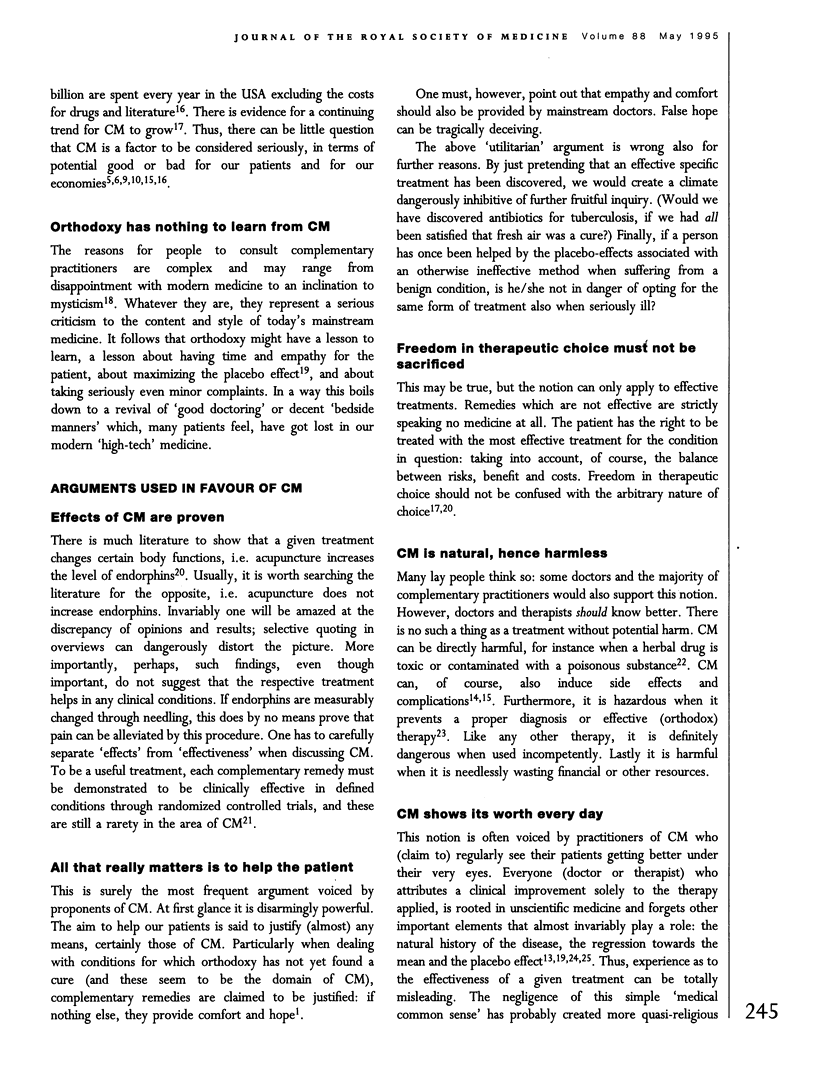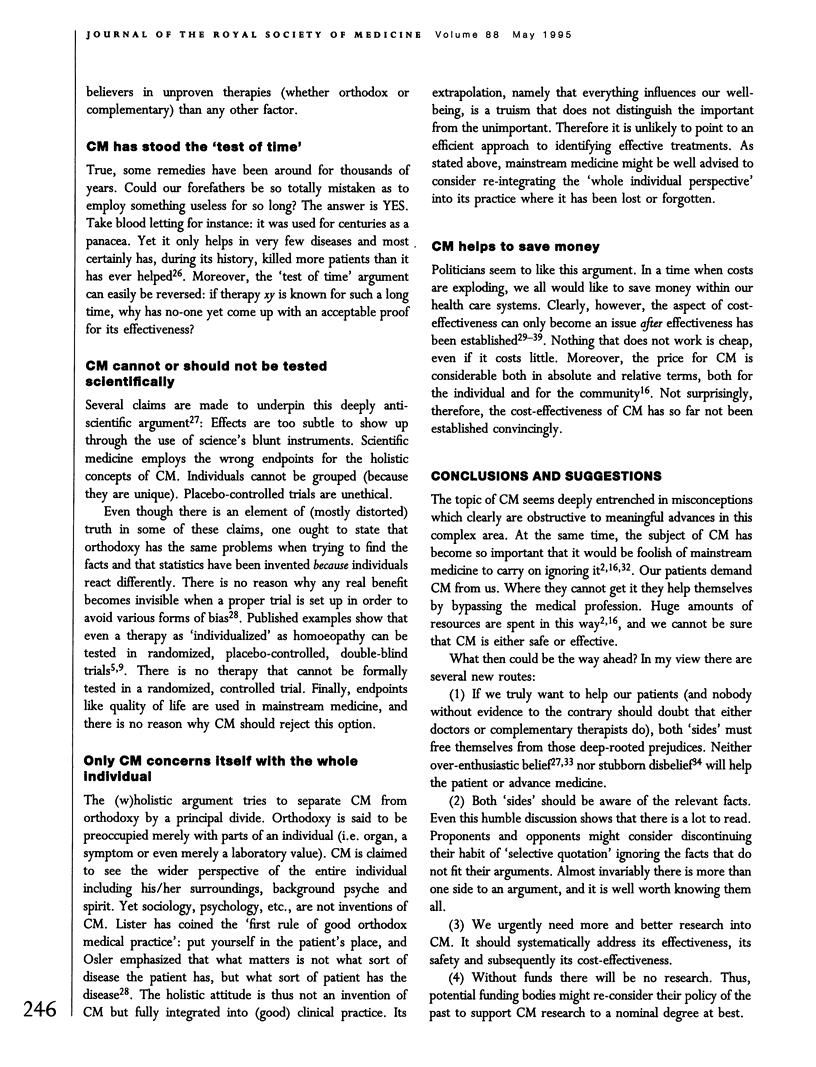Abstract
Complementary medicine (CM), defined as health care which lies for the most part outside the mainstream of conventional medicine, is gaining popularity in Britain and elsewhere. In the UK the most prevalent therapies are manipulation (used by 36% of the population), herbalism (24%) homoeopathy (16%) and acupuncture (16%). Due to the heterogeneity of CM, it is often problematic to generalize. The debate about the usefulness of CM is often regrettably emotional, and thus unproductive. In the pursuit of a more fruitful way ahead, the following highlights some of the main arguments from both 'sides' and tries to disguise them as misconceptions.
Full text
PDF



Selected References
These references are in PubMed. This may not be the complete list of references from this article.
- Barrett S. Commercial hair analysis. Science or scam? JAMA. 1985 Aug 23;254(8):1041–1045. [PubMed] [Google Scholar]
- Brewin T. B. Fraternizing with fringe medicine. Br J Gen Pract. 1994 Jun;44(383):243–244. [PMC free article] [PubMed] [Google Scholar]
- Brewin T. B. Logic and magic in mainstream and fringe medicine. J R Soc Med. 1993 Dec;86(12):721–723. doi: 10.1177/014107689308601215. [DOI] [PMC free article] [PubMed] [Google Scholar]
- Campion E. W. Why unconventional medicine? N Engl J Med. 1993 Jan 28;328(4):282–283. doi: 10.1056/NEJM199301283280413. [DOI] [PubMed] [Google Scholar]
- D'Arcy P. F. Adverse reactions and interactions with herbal medicines. Part 2--Drug interactions. Adverse Drug React Toxicol Rev. 1993 Autumn;12(3):147–162. [PubMed] [Google Scholar]
- Eisenberg D. M., Kessler R. C., Foster C., Norlock F. E., Calkins D. R., Delbanco T. L. Unconventional medicine in the United States. Prevalence, costs, and patterns of use. N Engl J Med. 1993 Jan 28;328(4):246–252. doi: 10.1056/NEJM199301283280406. [DOI] [PubMed] [Google Scholar]
- Ernst E. Behandlungsfreiheit oder Behandlungsbeliebigkeit? Kritische Gedanken zu alternativen Heilmethoden. Wien Klin Wochenschr. 1992;104(10):283–285. [PubMed] [Google Scholar]
- Ernst E. From alternative to complementary: changing the view on the fringe. 1993 Sep 15-Oct 5Br J Hosp Med. 50(6):299–300. [PubMed] [Google Scholar]
- Ernst E. Is homoeopathy a placebo? Br J Clin Pharmacol. 1990 Aug;30(2):173–174. doi: 10.1111/j.1365-2125.1990.tb03761.x. [DOI] [PMC free article] [PubMed] [Google Scholar]
- Ernst E. Scrutinising the alternatives. Lancet. 1993 Jun 26;341(8861):1626–1626. doi: 10.1016/0140-6736(93)90763-7. [DOI] [PubMed] [Google Scholar]
- Fisher P., Ward A. Complementary medicine in Europe. BMJ. 1994 Jul 9;309(6947):107–111. doi: 10.1136/bmj.309.6947.107. [DOI] [PMC free article] [PubMed] [Google Scholar]
- Glymour C., Stalker D. Sounding board. Engineers, cranks, physicians, magicians. N Engl J Med. 1983 Apr 21;308(16):960–964. doi: 10.1056/NEJM198304213081611. [DOI] [PubMed] [Google Scholar]
- Goodwin J. S., Goodwin J. M. The tomato effect. Rejection of highly efficacious therapies. JAMA. 1984 May 11;251(18):2387–2390. doi: 10.1001/jama.251.18.2387. [DOI] [PubMed] [Google Scholar]
- Kleijnen J., Knipschild P. Ginkgo biloba. Lancet. 1992 Nov 7;340(8828):1136–1139. doi: 10.1016/0140-6736(92)93158-j. [DOI] [PubMed] [Google Scholar]
- Kleijnen J., Knipschild P., ter Riet G. Clinical trials of homoeopathy. BMJ. 1991 Feb 9;302(6772):316–323. doi: 10.1136/bmj.302.6772.316. [DOI] [PMC free article] [PubMed] [Google Scholar]
- Knipschild P. Looking for gall bladder disease in the patient's iris. BMJ. 1988 Dec 17;297(6663):1578–1581. doi: 10.1136/bmj.297.6663.1578. [DOI] [PMC free article] [PubMed] [Google Scholar]
- MacGregor F. B., Abernethy V. E., Dahabra S., Cobden I., Hayes P. C. Hepatotoxicity of herbal remedies. BMJ. 1989 Nov 4;299(6708):1156–1157. doi: 10.1136/bmj.299.6708.1156. [DOI] [PMC free article] [PubMed] [Google Scholar]
- Northcott H. C., Bachynsky J. A. Concurrent utilization of chiropractic, prescription medicines, nonprescription medicines and alternative health care. Soc Sci Med. 1993 Aug;37(3):431–435. doi: 10.1016/0277-9536(93)90273-7. [DOI] [PubMed] [Google Scholar]
- Oh V. M. The placebo effect: can we use it better? BMJ. 1994 Jul 9;309(6947):69–70. doi: 10.1136/bmj.309.6947.69. [DOI] [PMC free article] [PubMed] [Google Scholar]
- Patel M., Gutzwiller F., Paccaud F., Marazzi A. A meta-analysis of acupuncture for chronic pain. Int J Epidemiol. 1989 Dec;18(4):900–906. doi: 10.1093/ije/18.4.900. [DOI] [PubMed] [Google Scholar]
- Puett D. W., Griffin M. R. Published trials of nonmedicinal and noninvasive therapies for hip and knee osteoarthritis. Ann Intern Med. 1994 Jul 15;121(2):133–140. doi: 10.7326/0003-4819-121-2-199407150-00010. [DOI] [PubMed] [Google Scholar]
- Shekelle P. G., Adams A. H., Chassin M. R., Hurwitz E. L., Brook R. H. Spinal manipulation for low-back pain. Ann Intern Med. 1992 Oct 1;117(7):590–598. doi: 10.7326/0003-4819-117-7-590. [DOI] [PubMed] [Google Scholar]
- Smith R. Where is the wisdom...? BMJ. 1991 Oct 5;303(6806):798–799. doi: 10.1136/bmj.303.6806.798. [DOI] [PMC free article] [PubMed] [Google Scholar]
- Soragna D., Montalbetti L., Bo P., Sibilla L., Savoldi F. Chiropractic complications. Another case report. Acta Neurol (Napoli) 1993 Apr;15(2):145–150. [PubMed] [Google Scholar]
- Turner J. A., Deyo R. A., Loeser J. D., Von Korff M., Fordyce W. E. The importance of placebo effects in pain treatment and research. JAMA. 1994 May 25;271(20):1609–1614. [PubMed] [Google Scholar]


